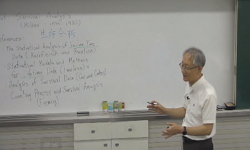본 연구는 콕스회귀분석과 누적한계추정법으로 1995년부터 2015년까지 1,084개의 국내 소프트웨어 기업을 분석하고, 생존율과 생존의 결정요인을 밝히는 것이다. 분석 결과 생존율의 경우, IT서...
http://chineseinput.net/에서 pinyin(병음)방식으로 중국어를 변환할 수 있습니다.
변환된 중국어를 복사하여 사용하시면 됩니다.
- 中文 을 입력하시려면 zhongwen을 입력하시고 space를누르시면됩니다.
- 北京 을 입력하시려면 beijing을 입력하시고 space를 누르시면 됩니다.


기업의 생존요인 연구 : 국내 소프트웨어 기업을 중심으로 = A Study on Firm Survival Factors: Focusing on Korean Software Firms
한글로보기https://www.riss.kr/link?id=A105938493
- 저자
- 발행기관
- 학술지명
- 권호사항
-
발행연도
2018
-
작성언어
Korean
- 주제어
-
등재정보
KCI등재,SCOPUS
-
자료형태
학술저널
- 발행기관 URL
-
수록면
98-121(24쪽)
-
KCI 피인용횟수
0
- DOI식별코드
- 제공처
-
0
상세조회 -
0
다운로드
부가정보
국문 초록 (Abstract)
본 연구는 콕스회귀분석과 누적한계추정법으로 1995년부터 2015년까지 1,084개의 국내 소프트웨어 기업을 분석하고, 생존율과 생존의 결정요인을 밝히는 것이다. 분석 결과 생존율의 경우, IT서비스, 패키지 소프트웨어, 게임 소프트웨어, 인터넷 서비스 각 분야별로 다른 형태를 보였다. 또한 연구개발 투자와 기업의 매출액 및 자산증가율로 나타나는 성장성은 생존에 긍정적이었으며, 여유자원은 부정적인 영향을 미쳤으며, 나이와 규모는 그 영향을 찾을 수 없었다. 이러한 결과는 소프트웨어 기업의 생존 전략과 정부의 지원 정책에 있어서 산업과 기술의 특성을 고려해야 한다는 점을 시사한다. 본 연구는 90년대 말 외환위기라는 특수 상황이나 제조업 중심으로 진행된 국내 생존분석의 영역을 최근 중요성이 커지는 소프트웨어 산업으로 확장했다는 의미가 있다.
다국어 초록 (Multilingual Abstract)
This article analyzes the survival of Korean software firms from 1995 to 2015 by Cox regression model and product-limit method. The results show that survival rates are different for each sector: IT service, package software, game software and interne...
This article analyzes the survival of Korean software firms from 1995 to 2015 by Cox regression model and product-limit method. The results show that survival rates are different for each sector: IT service, package software, game software and internet service. In addition, firm growth and investment in research and development positively affect software firm’s survival, while slack resources negatively affect the software firm’s survival. The implication of this study is that characteristics of the software industry and technologies should be taken into consideration in survival strategy of software firms and government policy. Previous research on survival analysis has been mainly conducted in the manufacturing industry or at the special circumstance such as the foreign exchange crisis of Korea in the late 1990s. The contribution of this study is that expanding the survival analysis to software firms in Korea which are becoming more important recently.
참고문헌 (Reference)
1 이병기, "해저드모형에 의한 신생기업의 생존요인 분석" 한국국제경제학회 11 (11): 131-154, 2005
2 이상호, "중소 전자 기업의 생존요인 분석" 4 (4): 93-112, 1998
3 안세연, "장수기업의 공통 경영 방식에 관한 연구: 기업의 장기생존 가능성을 높이는 장수루틴은 존재하는가?" 한국경영학회 43 (43): 889-917, 2014
4 송치승, "우리나라 벤처기업의 미시적 특성과 생존요인 분석" 한국중소기업학회 14 (14): 1-24, 2011
5 나상균, "신생기업의 생존요인 분석 : 기술혁신 제조기업을 중심으로" 대한경영학회 20 (20): 1325-1340, 2007
6 박세정, "생존분석기법을 이용한 상호저축은행 부실예측" 예금보험공사 9 (9): 31-62, 2008
7 차명수, "기업 초기 최고경영진 및 최고경영자의 특성이 ICT 벤처기업의 장기생존에 미치는 영향" 한국인사조직학회 25 (25): 195-234, 2017
8 남재우, "기업 도산 예측을 위한 생존분석 기법의 응용" 5 (5): 29-61, 2000
9 김진수, "기술혁신활동이 부도위험에 미치는 영향:한국 유가증권시장 및 코스닥시장 상장기업을 중심으로" 기술경영경제학회 17 (17): 55-80, 2009
10 장세진, "경영자원론과 기업진화론을 중심으로 한 전략경영이론의 최근 동향" 1 (1): 49-73, 1998
1 이병기, "해저드모형에 의한 신생기업의 생존요인 분석" 한국국제경제학회 11 (11): 131-154, 2005
2 이상호, "중소 전자 기업의 생존요인 분석" 4 (4): 93-112, 1998
3 안세연, "장수기업의 공통 경영 방식에 관한 연구: 기업의 장기생존 가능성을 높이는 장수루틴은 존재하는가?" 한국경영학회 43 (43): 889-917, 2014
4 송치승, "우리나라 벤처기업의 미시적 특성과 생존요인 분석" 한국중소기업학회 14 (14): 1-24, 2011
5 나상균, "신생기업의 생존요인 분석 : 기술혁신 제조기업을 중심으로" 대한경영학회 20 (20): 1325-1340, 2007
6 박세정, "생존분석기법을 이용한 상호저축은행 부실예측" 예금보험공사 9 (9): 31-62, 2008
7 차명수, "기업 초기 최고경영진 및 최고경영자의 특성이 ICT 벤처기업의 장기생존에 미치는 영향" 한국인사조직학회 25 (25): 195-234, 2017
8 남재우, "기업 도산 예측을 위한 생존분석 기법의 응용" 5 (5): 29-61, 2000
9 김진수, "기술혁신활동이 부도위험에 미치는 영향:한국 유가증권시장 및 코스닥시장 상장기업을 중심으로" 기술경영경제학회 17 (17): 55-80, 2009
10 장세진, "경영자원론과 기업진화론을 중심으로 한 전략경영이론의 최근 동향" 1 (1): 49-73, 1998
11 전용석, "건설기업의 생존예측모형" 대한건축학회 18 (18): 165-172, 2002
12 김상지, "각인효과와 신생기업의 생존: 창업초기 최고경영진의 특성이 벤처기업의 생존에 미치는 영향" 한국인사관리학회 41 (41): 1-19, 2017
13 Bercovitz, J., "When is more better? The impact of business scale and scope on long‐term business survival, while controlling for profitability" 28 (28): 61-79, 2007
14 Alchian, A. A., "Uncertainty, evolution, and economic theory" 58 (58): 211-221, 1950
15 Wiseman, R. M., "Toward a model of risk in declining organizations: An empirical examination of risk, performance and decline" 7 (7): 524-543, 1996
16 Jensen, M. C., "Theory of the firm: Managerial behavior, agency costs and ownership structure" 3 (3): 305-360, 1976
17 Mata, J., "The survival of new plants: Start-up conditions and post-entry evolution" 13 (13): 459-481, 1995
18 Hannan, M. T., "The population ecology of organizations" 82 (82): 929-964, 1977
19 Barnett, W. P., "The organizational ecology of a technological system" 35 (35): 31-60, 1990
20 De Geus, A., "The living company : habits for survival in a turbulent environment" Nicholas Brealey 1997
21 Voss, G. B., "The effects of slack resources and environmental threat on product exploration and exploitation" 51 (51): 147-164, 2008
22 Santarelli, E., "The duration of new firms in banking: an application of Cox regression analysis" 25 (25): 315-325, 2000
23 Opler, T., "The determinants and implications of corporate cash holdings" 52 (52): 3-46, 1999
24 Chen, M. Y., "Survival duration of plants: Evidence from the US petroleum refining industry" 20 (20): 517-555, 2002
25 Brüderl, J, "Small business mortality in Germany: a comparison between regions and sectors" WZB 1996
26 Silverman, B. S., "Profitability, transactional alignment, and organizational mortality in the US trucking industry" 18 : 31-52, 1997
27 Giarratana, M. S., "Product strategies and survival in Schumpeterian environments: Evidence from the US security software industry" 28 (28): 909-929, 2007
28 Moses, O. D., "Organizational slack and risk-taking behaviour: tests of product pricing strategy" 5 (5): 38-54, 1992
29 Cheng, J. L., "Organizational slack and response to environmental shifts: The impact of resource allocation patterns" 23 (23): 1-18, 1997
30 Tan, J., "Organizational slack and firm performance during economic transitions: Two studies from an emerging economy" 24 (24): 1249-1263, 2003
31 Baum, J. A., "Organizational niches and the dynamics of organizational mortality" 100 (100): 346-380, 1994
32 Brüderl, J., "Organizational mortality: The liabilities of newness and adolescence" 35 (35): 530-547, 1990
33 Carroll, G. R., "Organizational mortality in the newspaper industries of Argentina and Ireland: An ecological approach" 27 (27): 169-198, 1982
34 Bourgeois III, L. J., "On the measurement of organizational slack" 6 (6): 29-39, 1981
35 Kaplan, E. L., "Nonparametric estimation from incomplete observations" 53 (53): 457-481, 1958
36 Audretsch, D. B., "New firm survival: new results using a hazard function" 77 (77): 97-103, 1995
37 Audretsch, D. B., "New firm survival: Industry versus firm effects" Tinberg Institute 1997
38 Stuart, T. E., "Local search and the evolution of technological capabilities" 17 (17): 21-38, 1996
39 McCloughan, P., "Life duration of foreign multinational subsidiaries: Evidence from UK northern manufacturing industry 1970–93" 16 (16): 719-747, 1998
40 Fichman, M., "Honeymoons and the liability of adolescence:A new perspective on duration dependence in social and organizational relationships" 16 (16): 442-468, 1991
41 Teece, D. J., "Explicating dynamic capabilities: the nature and microfoundations of (sustainable) enterprise performance" 28 (28): 1319-1350, 2007
42 Winter, S. G., "Economic natural selection and the theory of the firm" Yale University 1964
43 Das, S., "Duration of firms in an infant industry: the case of Indian computer hardware" 53 (53): 157-167, 1997
44 Katz, M., "Competition, Innovation and the Microsoft monopoly: Antitrust in the digital marketplace, The Progress and Freedom Foundation" Kluwer Academic Publishers 1999
45 Dierickx, I., "Asset stock accumulation and sustainability of competitive advantage" 35 (35): 1504-1511, 1989
46 Mishina, Y., "Are more resources always better for growth? Resource stickiness in market and product expansion" 25 (25): 1179-1197, 2004
47 Martinez, R. J., "An examination of firm slack and risk-taking in regulated and deregulated airlines" 18 (18): 11-31, 2006
48 Cefis, E., "A matter of life and death: innovation and firm survival" 14 (14): 1167-1192, 2005
동일학술지(권/호) 다른 논문
-
동적 패널모형을 이용한 산업용 로봇 도입의 결정요인 분석
- 기술경영경제학회
- 정진화
- 2018
- KCI등재,SCOPUS
-
- 기술경영경제학회
- 이태훈
- 2018
- KCI등재,SCOPUS
-
텍스트마이닝을 활용한 공개데이터 기반 기업 및 산업 토픽추이분석 모델 제안
- 기술경영경제학회
- 박선영
- 2018
- KCI등재,SCOPUS
-
학술연구의 동향 및 정책과의 상호관계 분석 :중소기업 기술혁신정책을 중심으로
- 기술경영경제학회
- 정효정
- 2018
- KCI등재,SCOPUS
분석정보
인용정보 인용지수 설명보기
학술지 이력
| 연월일 | 이력구분 | 이력상세 | 등재구분 |
|---|---|---|---|
| 2023 | 평가예정 | 재인증평가 신청대상 (재인증) | |
| 2020-01-01 | 평가 | 등재학술지 선정 (재인증) |  |
| 2019-12-01 | 평가 | 등재후보로 하락 (계속평가) |  |
| 2016-01-01 | 평가 | 등재학술지 유지 (계속평가) |  |
| 2015-01-01 | 평가 | 등재학술지 유지 (등재유지) |  |
| 2011-01-01 | 평가 | 등재 1차 FAIL (등재유지) |  |
| 2009-01-01 | 평가 | 등재학술지 유지 (등재유지) |  |
| 2006-01-01 | 평가 | 등재학술지 선정 (등재후보2차) |  |
| 2005-05-25 | 학술지명변경 | 한글명 : 기슬혁신연구 -> 기술혁신연구 |  |
| 2005-01-01 | 평가 | 등재후보 1차 PASS (등재후보1차) |  |
| 2003-01-01 | 평가 | 등재후보학술지 선정 (신규평가) |  |
학술지 인용정보
| 기준연도 | WOS-KCI 통합IF(2년) | KCIF(2년) | KCIF(3년) |
|---|---|---|---|
| 2016 | 0.54 | 0.54 | 0.88 |
| KCIF(4년) | KCIF(5년) | 중심성지수(3년) | 즉시성지수 |
| 0.92 | 0.92 | 1.204 | 0.06 |





 ScienceON
ScienceON 코리아스칼라
코리아스칼라



